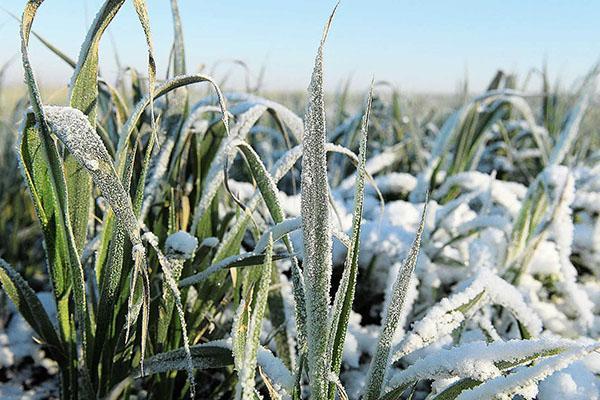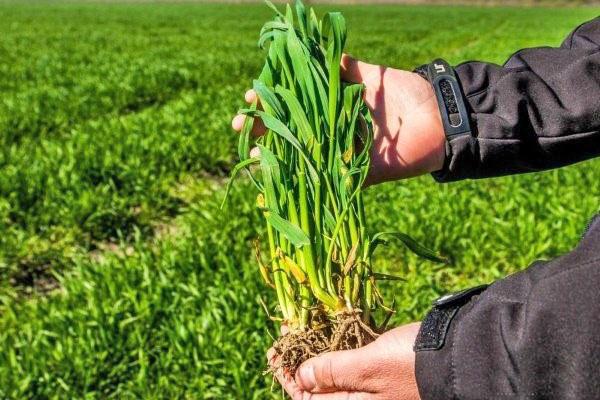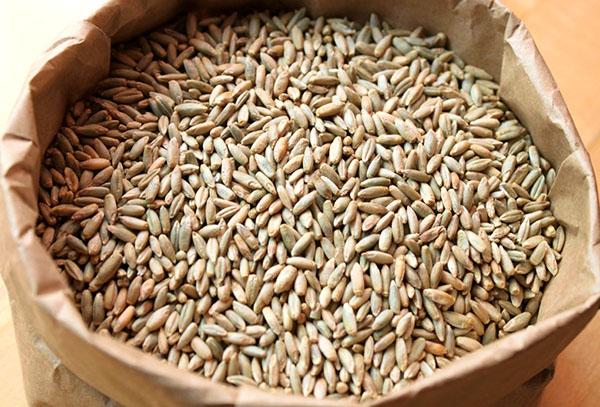We sow rye in autumn as green manure to improve soil composition
 To restore the fertility and structure of the soil, organic fertilizers are systematically applied to the soil. However, if the farm does not have cow dung, then gardeners try to sow rye in the fall as a siderat. Winter varieties of this cereal crop provide a huge amount of green mass. Unlike the spring variety, which is planted in spring, this variety does not begin to spike ahead of time, but, on the contrary, forms dense bushes.
To restore the fertility and structure of the soil, organic fertilizers are systematically applied to the soil. However, if the farm does not have cow dung, then gardeners try to sow rye in the fall as a siderat. Winter varieties of this cereal crop provide a huge amount of green mass. Unlike the spring variety, which is planted in spring, this variety does not begin to spike ahead of time, but, on the contrary, forms dense bushes.

When is it advisable to sow rye in the fall as a siderat
 This cereal plant is in the TOP-3 of the best green manure crops in agriculture, because it saturates the soil with an incredible amount of nutrients than all other plants. Thanks to the fibrous root system, the crop sprouts grow so quickly that they manage to absorb all the nutrients before any weed grass. In addition, this cereal has a high biological activity, which allows it to obtain useful compounds from substances that are difficult to digest. However, the question arises when to sow winter rye as a siderat in order to maximize its full potential.
This cereal plant is in the TOP-3 of the best green manure crops in agriculture, because it saturates the soil with an incredible amount of nutrients than all other plants. Thanks to the fibrous root system, the crop sprouts grow so quickly that they manage to absorb all the nutrients before any weed grass. In addition, this cereal has a high biological activity, which allows it to obtain useful compounds from substances that are difficult to digest. However, the question arises when to sow winter rye as a siderat in order to maximize its full potential.
 The cereal crop has one important feature - it is able to increase its biomass within 45 days. By the end of this period, it becomes fully winter-suitable.
The cereal crop has one important feature - it is able to increase its biomass within 45 days. By the end of this period, it becomes fully winter-suitable.
Therefore, it is sown immediately after harvesting vegetables:
- the end of August - on the 20th;
- at the beginning of autumn;
- the last decade of September.
The terms given here will be optimal only for central Russia. However, in the southern regions, the best time to sow rye is usually October. This month, farmers completely remove all other crops from their gardens: beets, carrot and cabbage. In addition, the warm weather in this area lasts almost until the end of November.
If the greens of cereal plants outgrow, then the stems become too rigid. To process vegetation for fertilization, soil microorganisms have to absorb all nitrogen reserves from the soil.
Technology of growing rye as a siderat: how many seeds do you need and how to care for seedlings
 Many gardeners prefer to sow a cereal crop as the site is vacated. Others are waiting for the time when they will free him completely. They divide it into beds in 15 cm increments, or they distribute the seeds in a chaotic manner, sowing in bulk. However, after that, they do not go on vacation, but continue to look after their lands.
Many gardeners prefer to sow a cereal crop as the site is vacated. Others are waiting for the time when they will free him completely. They divide it into beds in 15 cm increments, or they distribute the seeds in a chaotic manner, sowing in bulk. However, after that, they do not go on vacation, but continue to look after their lands.
There are several features of growing rye as a siderat:
- Sowing agrotechnics. For 1 hundred square meters of a personal plot, you will need to prepare up to 1-3 kg of ripe seeds. The planting depth of grains ranges from 2 to 5 cm. To achieve this precise effect, some farmers use a rake.

- Watering. Most of the rhizome of the culture is mainly concentrated in the upper layer of the earth. Therefore, the plant desperately needs a sufficient amount of moisture. For this, at the stage of preparatory work, if September was without rain, the site is thoroughly irrigated with water.

- Top dressing.Although rye survives on highly depleted soil types, agronomists still recommend periodically applying fertilizer to the soil. Nitrophoska is often used as such a nutritional supplement (with a calculation of 20 g / m²).

For sowing, it is recommended to buy last year's seed. Seeds that are too young simply do not have time to go through a full-fledged ripening process, therefore they have a low germination rate. In addition, farmers are urged not to plant this cereal crop near fruit trees or shrubs. Otherwise, the plant will absorb all available moisture reserves at the summer cottage.
The seeding depth for each type of soil is different. For sandy loam, this indicator is 5 cm, for clayey - 2 cm, and for all others - 3 cm.
Features of digging rye as a sederate: the choice is up to the gardener
 Sowing a cereal crop is only half the battle. The seedlings still need to be handled correctly. Now it's time to find out what to do with the rye planted in the fall.
Sowing a cereal crop is only half the battle. The seedlings still need to be handled correctly. Now it's time to find out what to do with the rye planted in the fall.
Agronomists offer several options for solving this issue:
- Leave the landing in this state for the upcoming winter. The advantage of this method is that the microflora in the upper layers of the soil is not destroyed by sunlight during digging.

- Mow juicy shoots before frost. By that time, they should have reached 30 cm. The site can be dug up or mulched with the obtained biomass.
- In early spring, mow all available greens. Then dig it up together with the earth to a depth of 12-15 cm (for light soils) or 6-8 cm (for heavy soils).
- After mowing, leave the stems on the site as mulch... After 2-3 weeks, when the greens decay, loosen the top layer of soil and plant vegetables.

Still, it should be borne in mind that rye in the garden brings both benefits and harm. Planting it regularly in the same place leads to drying out of the land.
The manure contains a lot of weed seeds. If the farmer constantly brings organic matter into the garden, then he personally contributes to the cultivation of weeds in the country. However, by sowing rye like green manure in the fall, the grower protects the site from weeds. Among other things, dense crops of cereals trap snow and rainwater at the desired depth, thereby evenly distributing moisture and keeping it in the ground.
Sometimes the gardener does not have time to remove the crop, and it outgrows. In such cases, it is mowed and disposed of. And when young shoots appear, the soil is plowed again.
Rye as a siderat is not suitable for all crops
 Since the cereal is sown in late summer or early autumn, it starts growing early enough in the spring. This happens when the temperature rises by only 2-3˚С. By the second half of April, the seedlings of the culture reach 30 cm and are suitable for repeated mowing. Based on these features, most often rye as a siderat is used for potatoes and other late crops.
Since the cereal is sown in late summer or early autumn, it starts growing early enough in the spring. This happens when the temperature rises by only 2-3˚С. By the second half of April, the seedlings of the culture reach 30 cm and are suitable for repeated mowing. Based on these features, most often rye as a siderat is used for potatoes and other late crops.
It is sown in areas designated for:
- cucumbers;
- zucchini;
- pepper;
- cabbage;
- eggplant;
- tomatoes;
- strawberries;
- beets;
- pumpkin.
 After the green manure, the soil becomes looser, as well as air and moisture permeable. Moreover, it is enriched with many minerals, because during decomposition the culture releases a sufficient amount of phosphorus, nitrogen and potassium into the soil. At the same time, this cereal contributes to the destruction of pests such as wireworm and nematodes.
After the green manure, the soil becomes looser, as well as air and moisture permeable. Moreover, it is enriched with many minerals, because during decomposition the culture releases a sufficient amount of phosphorus, nitrogen and potassium into the soil. At the same time, this cereal contributes to the destruction of pests such as wireworm and nematodes.
In addition, planting rye after potatoes inhibits the growth of malicious weeds:
- wheatgrass;
- squid;
- bindweed;
- swans;
- sow thistle.
 Farmers practice using several green manure crops at once. Sowing oats, vetch, ryegrass and phacelia in a company with rye saturates the site as much as possible with all useful macro- and microelements.
Farmers practice using several green manure crops at once. Sowing oats, vetch, ryegrass and phacelia in a company with rye saturates the site as much as possible with all useful macro- and microelements.
Rye is not a desirable precursor for nightshades and all other cereals.
As you can see, it is better to use winter rye as a siderat in autumn, because it quickly gains green mass in spring.Of course, the farmer will have to decide on his own when to mow and embed it in the soil. If he does everything right, then the garden will delight him with a rich harvest.